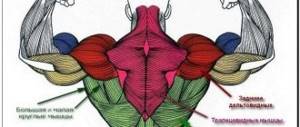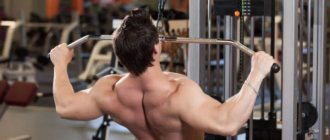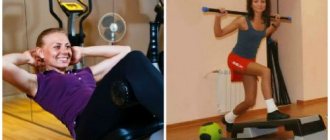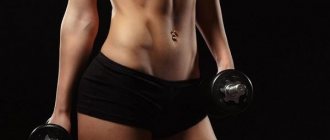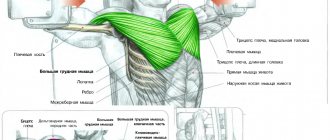Set of exercises aimed at restoring flexibility and mobility of your spine. Exercises will help with back pain, improve posture and overall well-being.
What exercises should you do to keep your spine healthy?
In the video, I explained in detail and visually performed exercises with which you can begin to pump up problem areas of your back. First, you need to start with simple exercises and gradually increase complexity as you become more trained and tone your muscles. At the end I did a simple “cat” exercise, which trains flexibility and allows you to slightly stretch your back muscles.
Read: How to warm up before training
Why do you need to strengthen your back muscles?
The spine is one of the main elements of the human skeleton; well-being, endurance and health depend on its condition. It serves as a support for the body and participates in its slightest movements. Even when you lie and stand, the spine works and experiences stress. The sitting position is the least physiological for him, so the appearance of pain in the lower back and thoracic region most often worries office workers.
Strengthening the back muscles is aimed at keeping the vertebrae in the correct position. The muscles surrounding the spine must always be in good shape to prevent involuntary displacement of the vertebrae. If this happens, blood circulation is disrupted and brain nutrition deteriorates. Not only pain in the lower back or chest area is of concern, but also chronic fatigue, fatigue, distracted attention, forgetfulness - this is how the brain responds to insufficient blood supply.
These conditions are rarely associated with back problems. And dealing with them is much more difficult than preventing them. By regularly performing these exercises, you will reduce the risk of vertebral displacement, improve your posture and feel much better.
There are no more or less important muscles in the body. All of them are involved in body movements, and therefore exercises to strengthen the back muscles must be combined with others. If you go to the gym or work out at home three to four times a week, perform a back routine once a week. If you train five times a week, do the complex twice.
Bent-over barbell row
Advantages:
This exercise ranks second among heavy lifting exercises. Research has shown that the bent-over row works both the upper and lower muscles equally, making it an excellent exercise for working the entire back. Like the deadlift, this exercise requires perfect technique, but it's worth it.
Bent-over barbell row with straight grip
When to do it:
Practice bent-over rows with heavy weights at the beginning of your workout, the number of repetitions per set is from 6 to 10 times. Doing this exercise in a Smith machine is also a good option. The machine keeps you in a vertical plane, but you need to make sure that your body is in the correct position relative to the bar. The bent over row puts much more stress on the lower back than other exercises. It’s worth taking pity on your lower back and doing this exercise at the beginning of your workout. If you're exhausted after deadlifting, it might be best to skip the bent-over row altogether.
How to properly perform exercises to develop back muscles
Here are some trainers' recommendations for doing the exercises.
1. Start by warming up your muscles. To prepare your muscles for the load, you need to warm them up. To do this, do several bends, turns from side to side, and circular swings of your arms. This will improve blood circulation and reduce the risk of injury.
2. Complete the complex with stretching. Stretching exercises are very useful for those who spend most of their time sitting. They return the spine to a physiological state and maintain its natural curve. Good stretching exercises:
- cat - get on all fours, arch your back as much as possible and hold for a few seconds, repeat three to four times;
- lumbar stretch - lie on your back and press your knees to your chest, hold and feel the muscles in your lower back stretch.
3. Consider the condition of your body. If this is your first time, strength training can be harmful. Bent-overs with dumbbells and squats with a barbell will only be useful if the body muscles are developed. If a beginner performs strength exercises, and even without the supervision of a trainer, there is a high risk of injury already in the first training session.
Do not use weights if you are just starting to strengthen your back. Progress to strength training gradually.
4. Think about what result you want to achieve. If you need to get rid of back pain and make your body flexible, improve your well-being, choose a complex without dumbbells. If you want to build muscle definition and help your body burn fat, choose strength training.
Deadlift
Advantages:
This exercise is not just for the back. It affects a range of muscles in the back of the body, from the calves to the upper trapezius. Deadlifts are the best way to work your entire backside. When performing the exercise, it is extremely important to follow the correct technique. Once you master it, increase the weight. This will help you recruit more muscles, release muscle growth hormones, and gain mass.
There are many different deadlift training programs that can help you set your personal bests. Instructors like to suggest the deadlift for building strength and endurance because it works the muscles and is the best for strengthening bone tissue.
Deadlift
Perform classic deadlifts on back day. Other popular variations, such as the sumo deadlift, target other muscles.
When to do it:
If you're doing heavy deadlifts (maximum 6 reps), it's best to do them early in your workout, when you're still full of strength. If you intend to perform many repetitions, but with light weight, then you can do this exercise at any time.
Top 5 exercises for developing back muscles in women
This complex will help relieve stress from the lower back and thoracic spine, relieve tension in the shoulders, and improve well-being during sedentary work. It is universal, as it is suitable for any level of physical fitness and does not pose the risk of injury. Each exercise must be performed 8-10 times, avoiding pain.
1. Stand up straight. Alternately tilt your head towards your shoulder while lifting it.
2. Raise your arms, place your palms behind your head and clasp them together. As you inhale, open your elbows to the sides and rotate your body. As you exhale, return to the starting position, arch your back and bring your elbows forward.
3. Get on all fours, place one hand behind your head, keep your elbow parallel to the floor. Move your elbow up while rotating your body to return to the starting position. Repeat with each hand.
4. Take a gymnastic stick or fitness band and hold it at arm's length. Raise your arms above your head and behind your shoulders. Return to the starting position.
5. Take a fitness band and raise your arms above your head. Bring them behind your back, squeezing your shoulder blades and pressing your elbows toward your body.
Wide grip pull-ups
Advantages:
Pull-ups are an excellent exercise for the back muscles. In wide-grip pull-ups, the main focus is on the upper latissimus muscles. A narrow grip increases the range of motion, but a wide grip places the body in a better starting position. The most difficult thing in this exercise is to maintain the desired pace with the number of repetitions from 8 to 12 times.
If you're doing pull-ups at the beginning of your workout, use a weight belt. If you find it difficult to perform this exercise, you can always replace it with a pull-up machine or use the help of a spotter. Also, a full-fledged replacement would be pulling the block down with a wide grip. If everything is in order with the shoulder joints, you can pull the block down behind your head.
It is extremely important to follow the execution technique: in the starting position, the shoulder blades should be brought together.
Wide grip pull-up on the horizontal bar
When to do it:
This exercise has a large range of motion, so a few repetitions will be enough to warm up the shoulder joints. Perform pull-ups at the beginning of your workout to focus on technique.
Smith Machine Reverse Grip Row
Advantages:
The reverse grip engages the biceps and keeps the elbows close to the body, placing the load on the lower lats. Smith machine training allows you to concentrate on increasing your weight without worrying about maintaining your balance.
When performing the exercise, stand close to the barbell and tilt your body at an angle of about 45 degrees. When using heavy weights, you may feel stress on your knees and hips. Some experienced bodybuilders consider the Smith machine to be dangerous to the joints, but the stability of the body during movement and the ability to work with heavy weights make it suitable for beginner athletes.
When to do it:
It is enough to perform one exercise using a reverse grip per workout. Do Smith machine rows in the middle of your workout after doing overhand pull-ups. Use traction straps to take your mind off the grip and focus on working your back muscles.
Pullover with dumbbell lying on an incline bench
Advantages:
Not everyone knows this, but pullovers are mostly a back exercise. The incline pullover uses the same muscles as the straight-arm lat pullover. This is a single-joint exercise that allows you to concentrate exclusively on working the latissimus muscles. Performing this exercise on an incline rather than a flat bench increases muscle load due to a greater range of motion. Lower the dumbbell behind your head, touching the floor at the bottom of the movement.
Incline Dumbbell Pullover
When to do it:
Single-joint exercises are almost always performed at the end of a workout on a specific body part. Don't slow down and do 12-15 repetitions per set.
Standing T-bar row
Advantages:
For pumping up the back, the standing T-bar row is better than the lying barbell row on a bench, despite the fact that standing increases the load on the knees and hips. If you find it difficult to keep your back straight, do this exercise while lying down.
There is no need to squat too much; keep your knees slightly bent at all times. The position of the hands and the width of the grip can be varied. A wide grip works the latissimus muscles, while a neutral grip will allow you to concentrate on pumping the muscles of the middle part of the back: rhomboids, round and trapezius muscles. This exercise is one of the easiest on our list.
Standing T-bar row
When to do it:
It is recommended to perform in the first part of the workout. Focus on stretching and contracting your back muscles rather than lifting heavy weights. Increase the range of motion by slightly spreading your shoulder blades at the bottom. Make sure your back is straight at the beginning of each movement.
Close-grip lat pull-down
Advantages:
Wide-grip lat pull-downs are similar to wide-grip pull-ups, so we'll use a narrow-grip version for this exercise. Research has shown that using a narrow neutral grip is the same as a regular grip: the same muscles will be used. A narrow grip gives a greater range of motion and increases the exposure time for the latissimus muscles.
Close-grip lat pulldown to chest
When to do it:
If you want to not just stretch your shoulders, but build muscle mass, then it is better to perform this exercise at the end of your workout, doing sets of 8-12 repetitions.
Make movements at a slow pace, contracting the muscles at the bottom and stretching them as you move up.
How to strengthen your lower back on the horizontal bar
At first glance, it is difficult to imagine how a horizontal bar can help us. But there are still benefits. Let's figure out what it is.
Why is the horizontal bar good for your back?
The crossbar has a certain benefit for your lower back. For example, you can use it to train the iliopsoas muscle. And as you remember, it makes a significant contribution to the formation of the correct shape of the lumbar curve of the spine.
We can also use spinal traction to our advantage. Firstly, hanging on the horizontal bar after training will help stretch the back muscles, including deep-lying ones. This will eliminate muscle spasms and prevent postural disorders. Secondly, hangs will remove some of the load from the intervertebral discs, helping to improve the flow of nutrients into them. After all, intervertebral discs absorb substances like a sponge - compressing and unclenching.
For what diseases can you exercise on the crossbar?
Exercising on the horizontal bar places certain demands on the condition of the musculoskeletal system. So not everyone can include the crossbar in their training program. But we'll start with the good news.
In many cases, even if you have some spinal diseases, you can exercise on the crossbar. Let me give you examples:
- Osteochondrosis is a dystrophic destruction of intervertebral discs. Exercising on the horizontal bar can serve as a prevention of osteochondrosis or slow down its progression. But it is worth considering that a neurological disease, if not treated in a timely manner, can lead to a number of complications - protrusions, hernias, radiculitis. And if training is still possible with protrusions, albeit under the supervision of a doctor, then with hernias it is contraindicated.
- For first-degree scoliosis, training on the crossbar is possible. For scoliosis close to the second degree, you should only exercise under the supervision of a specialist and use a gravitron to reduce the tensile load on the spine.
- Poor posture in the sagittal plane. These include thoracic kyphosis or lumbar lordosis.
When not to exercise on the horizontal bar
- With scoliosis above the first degree. In this case, training with your own weight or with significant weight in a gravitron can lead to serious complications.
- For herniated intervertebral discs.
- With exacerbation of diseases of the musculoskeletal system.
But these diseases do not put an end to your training. With an integrated approach, using physical therapy, physiotherapy and massage procedures, it is often possible to improve the state of posture and stop many diseases!
To study Methods for correcting posture in adults
Exercises to strengthen the lower back on the horizontal bar
As you may have already noticed, the main benefit of exercising on the bar is stretching the spine and its surrounding structures. Therefore, no matter what exercises you perform on the bar, you get a positive effect.
The best option for the back muscles are pull-ups with a wide and medium grip, performed in the range of 10-15 repetitions for 2-3 sets
To train the iliopsoas muscle, leg raises on the bar with additional twisting of the pelvis at the top point are suitable. Also do 10-15 repetitions in 2-3 sets. Make sure that the movements are smooth and occur only through muscle contraction.
The best gym workout programs
Target: total back mass
If you haven't given your back as much time and effort in the gym as your other muscle groups, it's likely falling behind. To boost the underperforming group, focus on a bulking training program.
Building mass comes down to hard work, mostly with free weights. Do sets of reps in the 8-10 rep range, resting between sets, usually 90-120 seconds, to regain your breath and strength. Deadlifts may require an extra minute of rest.
A set of exercises to gain mass in the back muscles
If you can't do 8-10 pull-ups, use a machine. And if 8-10 reps is too easy for you, wear a weight belt to add weight. 5 sets of 8-10 times | |
5 sets of 8-10 times | |
5 sets of 8-10 times | |
5 sets of 8-10 times |
Goal: Increase back thickness
Besides general underdevelopment of the back muscles, the most common problem is also “two-dimensionality”: your back has good width, but it is flat, like a prairie in the Midwest. You need to strengthen it and make it thicker so that it eventually becomes voluminous.
This is where wrist straps come in. You won't be able to hit your lats well in this workout without straps. At some point you will run out of steam, your workout will be derailed, and so will your lower back. Deadlifts are what you need to get a beastly back. The wrist straps will make sure that you can achieve a lot!
A set of exercises to increase thickness
3 sets of 8-10 reps (lower grip) 3 sets of 8-10 reps (overhead grip) | |
4 sets of 8-10 times per arm | |
4 sets of 8-10 times | |
5 sets of 8-10 times |
Goal: Increase width
A wide back is a great chance of having a V-shaped silhouette. In this set of back exercises for men at the gym, you will focus on the top of the V, that is, the upper muscle groups. Various pull-ups and horizontal rows will serve this purpose.
Full disclosure: Much of what we perceive as back width is just a visual factor of your bone structure. If you have wide collarbones, especially if you also have a narrow waist and hips, you will create the illusion of a wide back even if you don't have much muscle mass. However, anyone can make their back wider if they work with the right exercises like the ones listed below.
For all movements in these exercises, place your hands a couple of inches behind your shoulders on each side. If you try to use as much distance as possible, such as by grabbing the very ends of the bar for a row, you will not achieve full range of motion or full compression of your back muscles.
Don't go wide! Use an underhand grip on these exercises except for deadlifts. To do this, use a neutral position with your palms facing each other.
A set of exercises to increase back width
Note: Do 4 sets with your torso upright. then lower yourself to a 45-degree angle to the floor and do 8 more reps to your chest. 4 sets of 8 times (and 8 more repetitions) | |
4 sets of 10 times | |
4 sets of 10 reps (use wide handle) | |
Note: Choose a weight that you can only perform 10 reps with. and then do 6 more, overcoming yourself. 4 sets of 10 times (and 6 more times) |
Goal: Increasing back relief
Assuming you've already built up a decent amount of mass in your back, this workout will hone and refine it. We'll increase the number of reps and sets and target all parts of this large and complex muscle group we simply call "the back."
Fact: The more fat you have, the less detail you will see in all muscle groups. Being lean will allow you to show off more defined muscles, but there are several age-old techniques for developing back width regardless of your body fat level.
As you exercise, do your best to focus more on squeezing your muscles and feeling them stretch. This may mean slowing down your sets to realize this reduction. The goal is to feel this contraction deep within each muscle fiber, so if you have to slow down for this to happen, rest.
A set of exercises for detailing the back
Note: there are three approaches to the exercise. 3 sets of 10 times (and another 10 times) | |
Note: Do 10 times slowly and calmly, and then 10 times quickly and without pause, both at the beginning and at the end. 4 sets of 10 times | |
4 sets of 12 times
Note: Use the same weight you use for the upright row. After the last 12 reps, immediately drop to your knees and pull the bar toward your sternum for 12 reps. Add the weight needed for more stability 4 sets of 12 times | |
4 sets of 15 reps | |
4 sets of 15 reps per arm | |
4 sets of 20 reps | |
4 sets of 12-15 reps |
Purpose: to protect the lower back
If you've never had a lower back injury and don't deal with at least the occasional low back pain, consider yourself lucky. Few things are as painful as lower back problems. For those of us who strive to improve our performance in physical exercise, these issues can have a very negative and limiting effect on learning.
This is especially important when it comes to training your legs or back. When your lower back is in pain, you simply can't do all the exercises everyone around you wants to do. This doesn't mean you need to stop training your back until your lower back has recovered, it just means you need to have a plan and be mindful of what to avoid.
All types of pull-ups and horizontal rows, unlike rows and deadlifts, are safe exercises for the lower back because they do not place the lumbar spine in a loaded position. To make your rowing movements safe, use chest support to prevent you from arching your back too much.
The key to having a safe and productive workout is to stay on the pad during all rowing movements. If you allow your torso to lift off the pillow as you reach back, you will defeat the purpose of the support.
A set of exercises for the lower back
4 sets of 10 times | |
4 sets of 10 times | |
4 sets of 10 times | |
4 sets of 12 times | |
4 sets of 12 times | |
4 sets of 15 reps |
Goal: lay the foundations
Finally, a basic procedure for those just starting out. It should be simple but functional, like the time-tested exercises that have helped generations of bodybuilders build a strong foundation for a big back.
Beginners are best served by working hard on only a few productive exercises. Avoid the temptation to take more and sacrifice form in a misguided attempt to speed up progress. If you increase the weight too quickly, you may be able to move the weight around, but you won't gain muscle mass properly.
More often than not, trying to change weight too quickly ends in injury. Control your form and try to develop muscle memory. The back is the most difficult area to achieve this connection, so take your time and focus on each exercise.
Do the workouts the same way they are given. Avoid the temptation to add more exercises or sets, and don't resort to any high-intensity advanced techniques such as supersets or forced repetitions. You will soon have the opportunity to do this. For now, master the basics and work on getting your back muscles to contract and stretch with each exercise.

